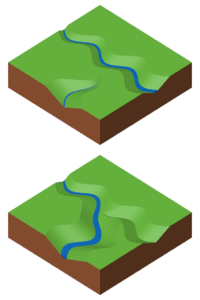Loading AI tools
Topographic gap made by a former waterway From Wikipedia, the free encyclopedia
A wind gap (or air gap)[1] is a gap through which a waterway once flowed that is now dry as a result of stream capture.[2] A water gap is a similar feature, but one in which a waterway still flows. Water gaps and wind gaps often provide routes which, due to their gently inclined profile, are suitable for trails, roads, and railroads through mountainous terrain.
The examples and perspective in this article deal primarily with the Blue Ridge Mountains in the state of Virginia in the United States and do not represent a worldwide view of the subject. (October 2019) |

Examples of wind gaps in the Blue Ridge Mountains of Virginia include Swift Run Gap, Rockfish Gap, and Buford's Gap. The last was the original crossing of the Blue Ridge Mountains near Bedford for the Virginia and Tennessee Railroad, later the Norfolk and Western Railway, a precursor of today's Norfolk Southern Railway system. Another wind gap with substantial importance in U.S. history is the Cumberland Gap near the junction of Kentucky, Virginia, and Tennessee.
Seamless Wikipedia browsing. On steroids.
Every time you click a link to Wikipedia, Wiktionary or Wikiquote in your browser's search results, it will show the modern Wikiwand interface.
Wikiwand extension is a five stars, simple, with minimum permission required to keep your browsing private, safe and transparent.